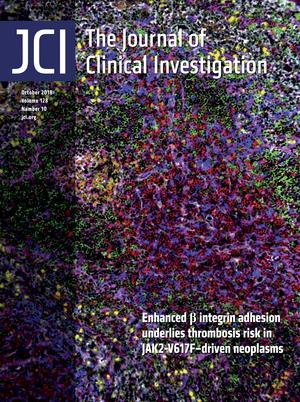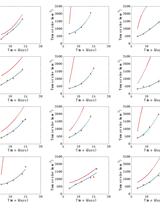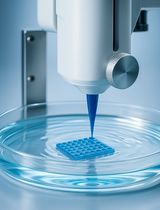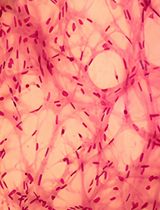- EN - English
- CN - 中文
3D Co-culture System of Mouse Prostatic Wild-type Fibroblasts with Human Prostate Cancer Epithelial Cells
小鼠前列腺野生型成纤维细胞和人前列腺癌上皮细胞的3D共培养系统
发布: 2019年05月05日第9卷第9期 DOI: 10.21769/BioProtoc.3225 浏览次数: 5738
评审: Gal HaimovichMarzia Di DonatoSalma Merchant
Abstract
Heterogeneous prostatic carcinoma-associated fibroblasts (CAF) contribute to tumor progression. This was established using transgenic mouse models. Paracrine interactions between fibroblasts and epithelial cells were further interrogated using isolated 2D cell culture systems, but 3D culture systems currently being developed can better mimic reciprocal interactions potentially found in the native tissue. To understand paracrine and juxtacrine signaling among fibroblasts and epithelia, 3D co-cultures with species differences allows for further subsequent analysis of the cultures. The use of mouse and human cells, for example, in one system allows for species-specific FACS or quantitative PCR analysis. This protocol describes the use of a 3D Co-culture System of Mouse Prostatic Wild-type Fibroblasts with Human Prostate Cancer Epithelial Cells.
Keywords: 3D Co-culture (3D共培养)Background
Prostate cancer (PCa) is a heterogeneous disease that results in the second highest cancer mortality in men. From the early steps of PCa initiation, the associated stromal fibroblastic cells begin to co-evolve with cancer progression and are predictive of recurrent disease and survival (Ayala et al., 2003). Studying paracrine signaling from the epithelial cancer cells to the associated fibroblasts and vice versa is imperative to understand the complex interactions during all stages of cancer progression (Bhowmick et al., 2004; Placencio et al., 2008). 2D culture systems where conditioned media from one cell type is incubated with the target cell type as well as those utilizing Boyden chamber cultures enable the exchange of paracrine factors. However, the characteristics of the cells in collagen matrix have documented differences in their responses to hormones and growth factors (Ziaee and Chung, 2014; Naba et al., 2014). Utilizing a 3D co-culture system allows a more representative readout of paracrine interactions between the stroma and epithelia. This system can be adapted for multiple combinations of stromal fibroblasts and cancer epithelial cells. Combinations of mouse and human cells can be used to better differentiate the cell type from which the signals were derived/received. Furthermore, incubation in a hypoxic chamber can more closely model physiologic environments. We have used localized prostate cancer as an example for our studies.
Materials and Reagents
- Pipette tips
- Sterile 1.5 ml microcentrifuge tubes
- Sterile 15 ml conical tubes
- 6-well cell culture plate (Fisher Scientific, catalog number: 08-772-49)
- Flat bottom 96-well plate (Fisher Scientific, catalog number: 07-200-90)
- 10 cm Tissue culture dish (Fisher Scientific, catalog number: 08-772E)
- Nylon mesh squares cut 2 cm x 2 cm (Elko Filtering Co., catalog number: 03-80/37)
- Metal grids, cut 2 cm x 2 cm, sterlized (Charcoal aluminum screen patches, Phifer incorporated, 3025123)
- FACS tubes (Corning, catalog number: 352235)
- Primary cultured mouse wild type prostatic fibroblasts (generated as previously described by Kato et al., 2018; Mishra et al., 2018)
- Human CWR22Rv1 epithelial cells (ATCC, catalog number: CRL-2505)
- 10x DMEM medium (Fisher Scientific, catalog number: SH3000203)
- Trypsin (Fisher Scientific, catalog number: MT25053CI)
- RPMI medium (Fisher Scientific, catalog number: SH3001103)
- DME/F12 medium (Fisher Scientific, catalog number: SH300404)
- Fetal Bovine Serum (Atlanta Biologicals, catalog number: S11550)
- NuSerum (Fisher Scientific, catalog number: 355500)
- Collagenase Type I (Invitrogen, catalog number: 17100-017)
- Dispase (Invitrogen, catalog number: 17105-041)
- BSA (MP Biomedicals, catalog number: 810034)
- Glutaraldehyde, 25% solution (Sigma, catalog number: G6257)
- Gentamicin (Life Technologies, catalog number: 15710-064)
- Insulin (human recombinant zinc, Gibco Life Technologies, catalog number: 12585-014)
- Testosterone (Testosterone propionate C-IIIN from Sigma-Aldrich, catalog number: T1875-5g)
- Anti-human CD105-APC antibody (eBiosciences, catalog number: 17-1057-41)
- Anti-human EpCAM-PE antibody (eBiosciences, catalog number: 12-9326-41)
- Rat tail collagen I (generated as previously described [Kato et al., 2018; Mishra et al., 2018], 6 month shelf life at 4 °C)
- Matrigel (BD Biosciences, catalog number: 354234)
- EBSS, 10x (Sigma-Aldrich, catalog number: E7510)
- NaHCO3
- NaOH
- Sterile distilled water
- NaCl
- NaH2PO4
- Na2HPO4
- RPMI complete epithelial medium (for CWR22Rv1) (see Recipes)
- DME/F12 Stromal complete medium (for mouse WT fibroblasts) (see Recipes)
- Setting solution (see Recipes)
- 1x PBS (See Recipes)
- Digestion solution (see Recipes)
Equipment
- Sterile forceps (Fine Science Tools, catalog number: 11254-20)
- Sterile Scissors (Fine Science Tools, catalog number: 14060-09)
- Sterile 10 ml serological pipette
- Biosafety cabinet for tissue culture work
- Pipette-aid
- Centrifuge with adaptors for 15-ml conical tubes, for use at room temperature
- Humidified cell culture incubator set to 37 °C and 5% CO2
- Humidified cell culture incubator set to 37 °C, 5% CO2, and 2% O2
- BD LSRII for flow cytometry
- Centrifuge for Eppendorf tubes
Software
- FlowJo software v10.3 was used for FACS analysis
Procedure
文章信息
版权信息
© 2019 The Authors; exclusive licensee Bio-protocol LLC.
如何引用
Placencio-Hickok, V. R., Kato, M. and Bhowmick, N. A. (2019). 3D Co-culture System of Mouse Prostatic Wild-type Fibroblasts with Human Prostate Cancer Epithelial Cells. Bio-protocol 9(9): e3225. DOI: 10.21769/BioProtoc.3225.
分类
癌症生物学 > 瘤形成 > 离体组织培养模型
癌症生物学 > 增殖信号转导 > 肿瘤微环境 > 增殖分析
细胞生物学 > 细胞分离和培养 > 3D细胞培养
您对这篇实验方法有问题吗?
在此处发布您的问题,我们将邀请本文作者来回答。同时,我们会将您的问题发布到Bio-protocol Exchange,以便寻求社区成员的帮助。
提问指南
+ 问题描述
写下详细的问题描述,包括所有有助于他人回答您问题的信息(例如实验过程、条件和相关图像等)。
Share
Bluesky
X
Copy link













